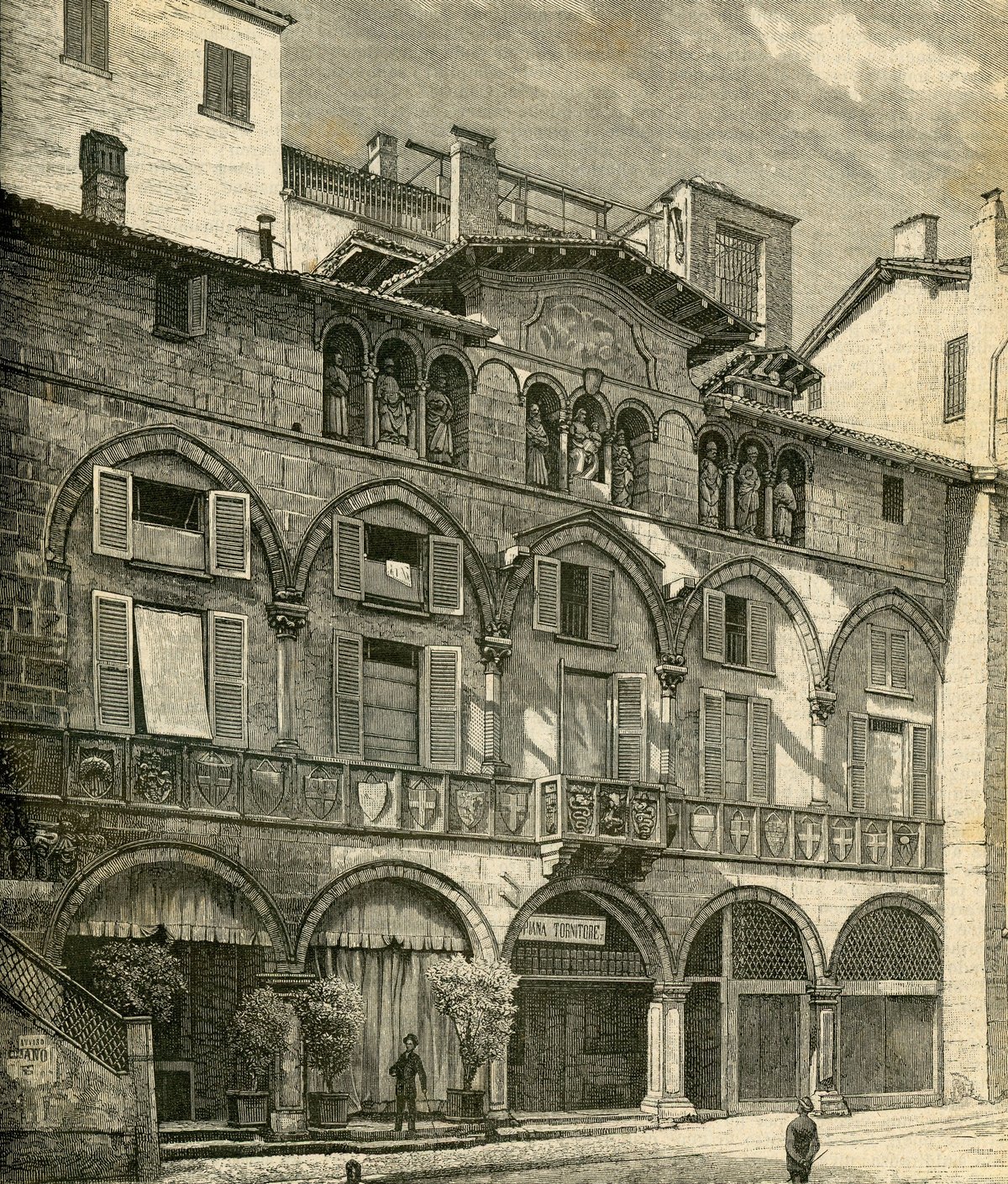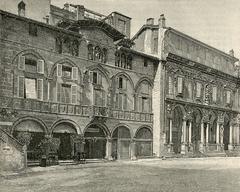
Loggia degli Osii Milan: Visiting Hours, Tickets, and Historical Guide
Date: 14/06/2025
Introduction: Discovering the Loggia degli Osii
In the heart of Milan’s Piazza dei Mercanti stands the Loggia degli Osii, a striking medieval monument that encapsulates the city’s rich civic traditions and architectural legacy. Commissioned in 1316 by Matteo I Visconti, then Lord of Milan, the Loggia was designed as a hub for judicial proceedings and public announcements, reflecting a transformative era in the city’s history (milano24ore.it; piazzamercanti.milano.it). Its unique black and white marble façade, inspired by Genoese design, along with heraldic emblems and the iconic “parlera” balcony, make it an essential stop for visitors interested in Milan’s medieval past.
Although the Loggia’s interior is not generally open to the public, its open arcades and ornate façade are freely accessible. Its central location, just steps from the Duomo di Milano, places it at the crossroads of Milan’s most significant historical sites. This detailed guide offers everything you need to know for your visit: from historical insights and architectural highlights to practical visitor information, accessibility, and nearby attractions.
Table of Contents
- Origins and Construction
- Architectural Features
- Civic and Judicial Significance
- Visiting Information
- Nearby Attractions & Guided Tours
- Visuals & Virtual Experiences
- FAQs
- Visconti Legacy & Symbolism
- Preservation & Restoration
- Historical Anecdotes & Community Life
- Events & Cultural Activities
- Summary & Planning Tips
- Sources
Origins and Construction
The Loggia degli Osii was commissioned in 1316 by Matteo I Visconti, marking a period when the Visconti family was consolidating power and reshaping Milan’s political landscape (milano24ore.it; A View On Cities). Designed by Scoto da San Gimignano, the Loggia served as the city’s judicial and notarial center. Its location in Piazza dei Mercanti—then Milan’s commercial and administrative core—underscored its practical and symbolic role at the heart of civic life.
The site was previously owned by the influential Osii family, for whom the Loggia is named (milanopocket.it). The building’s construction was enabled by the recent opening of the Naviglio Grande canal, which facilitated the transport of high-quality marble and other materials into the city (piazzamercanti.milano.it).
Architectural Features
The Loggia degli Osii is distinguished by its blend of local and external influences. The façade, arranged over three levels, features:
- Ground Floor: Large open arcades with round arches, providing shelter for public gatherings.
- First Floor: Pointed Gothic arches supporting the upper loggia, creating a sense of openness and accessibility.
- Upper Level: Five triple-arched windows (trifore), housing 19th-century copies of 14th-century statues—most notably the Madonna and Child, flanked by Milan’s patron saints (piazzamercanti.milano.it).
- Façade: Alternating bands of black and white marble—a motif typical of Genoese Gothic architecture, thought to honor Valentina Doria, a Genoese noblewoman who married into the Visconti family (milanopocket.it).
- Parlera Balcony: The central balcony, decorated with an eagle clutching its prey (symbolizing justice) and the Visconti coat of arms, served as the platform for official proclamations.
- Heraldic Frieze: The façade also displays the coats of arms of Milan’s historic districts, each named after one of the city’s medieval gates (lastsupperticket.com).
Civic and Judicial Significance
In medieval Milan, the Loggia degli Osii formed the centerpiece of the city’s legal and civic administration. Magistrates and notaries conducted official business under its arcades, with the “parlera” balcony serving as the stage for public announcements, legal verdicts, and proclamations (A View On Cities; milano24ore.it). The building’s design fostered transparency and citizen engagement—a hallmark of Italian city-states of the era.
The Loggia worked in concert with adjacent institutions like the Palazzo della Ragione (the former law court) and the Scuole Palatine (leading educational institution), creating a civic complex dedicated to governance, education, and commerce.
Visiting Information
Opening Hours
- The exterior of the Loggia degli Osii can be viewed at any time, as it is located in the open-air Piazza dei Mercanti.
- The interior is not open to the public as it houses municipal offices (milanopocket.it).
Tickets & Admission
- There is no entrance fee to view the Loggia from the square.
- Guided tours that include the Loggia and nearby sites may have a cost. Advance booking is recommended for popular tours.
Accessibility
- Piazza dei Mercanti is flat and wheelchair accessible, with smooth pavements and nearby benches.
- Some cobblestones may require caution for those with limited mobility.
Directions
- Metro: Duomo station (Lines M1 and M3), followed by a short walk.
- Tram: Lines 2, 3, and 12 stop near the Duomo.
- On Foot: The Loggia is a 3–5 minute walk from the Duomo and Galleria Vittorio Emanuele II.
Visitor Tips
- Visit early morning or late afternoon for the best lighting and fewer crowds.
- Wear comfortable shoes for exploring the historic center.
- Photography is encouraged—capture the façade and “parlera” balcony in natural light.
- Check for guided tours that provide deeper historical context.
Nearby Attractions & Guided Tours
- Palazzo della Ragione: Adjacent courthouse with exhibitions and guided tours.
- Casa dei Panigarola: Another medieval building with a rich history.
- Duomo di Milano: Milan’s iconic Gothic cathedral.
- Galleria Vittorio Emanuele II: Elegant 19th-century shopping arcade nearby.
Many city walking tours include the Loggia degli Osii and Piazza dei Mercanti, offering insights into Milan’s medieval governance and architecture (TravelTriangle).
Visuals & Virtual Experiences
- High-quality photographs and virtual tours are available on official Milan tourism websites.
- The Loggia’s distinctive façade and the lively Piazza dei Mercanti are ideal for photography.
- Official Milan Tourism Site - Loggia degli Osii
Frequently Asked Questions (FAQs)
Is the Loggia degli Osii open to the public?
No, the interior is not open for visits, but the exterior and open loggias can be viewed from Piazza dei Mercanti at any time.
Are tickets required?
No tickets are needed to view the Loggia’s exterior.
Can I take photos?
Yes, photography of the exterior is encouraged.
Is the site accessible for wheelchairs?
Yes, the square is flat and accessible.
Are guided tours available?
Yes, several city tours include the Loggia and surrounding sites.
The Visconti Legacy & Symbolism
The Loggia degli Osii stands as a testament to the authority and vision of the Visconti family. The family’s coat of arms and the eagle motif on the “parlera” balcony symbolize the era’s ideals of justice and governance (milano24ore.it). The building’s Genoese-inspired marble bands reflect Milan’s cosmopolitan influences and the city’s openness to artistic exchange.
Preservation & Restoration
Over the centuries, the Loggia underwent various modifications. In the 17th and 18th centuries, its arcades were walled up for residential use. An extensive restoration in 1904, led by Angelo Savoldi and Giovan Battista Borsani, restored its medieval character and architectural integrity (milanopocket.it). Ongoing conservation efforts ensure its continued role as a symbol of Milanese heritage.
Historical Anecdotes & Community Life
Piazza dei Mercanti, where the Loggia is located, was the nucleus of medieval Milanese civic life. The nearby “Stone of the Failed” is a relic of public justice, used to shame dishonest merchants (milano24ore.it). The Loggia’s balcony was the stage for official proclamations, wedding announcements, and community events, reinforcing the city’s commitment to transparency and civic participation.
Events & Cultural Activities
While the Loggia itself no longer hosts official events, Piazza dei Mercanti is a venue for cultural activities, especially during city festivals like the feast of St. Ambrose on December 7 (mediolan.pl). Guided tours often bring the Loggia’s history to life for visitors.
Summary & Planning Tips
The Loggia degli Osii is a remarkable example of medieval Milanese civic architecture, embodying the city’s values of justice, transparency, and public engagement. Its distinctive façade, symbolic balcony, and location among other historical landmarks make it a must-see for anyone interested in Milan’s heritage. Visit during quieter hours, take advantage of guided tours, and explore the surrounding Piazza dei Mercanti for a comprehensive experience.
Sources
- Visiting Loggia degli Osii: History, Tickets, Hours & Milan’s Historical Sites, 2025, Milano24ore
- Piazza Mercanti and Loggia degli Osii Official Site, 2025
- Visiting the Loggia degli Osii in Milan: Hours, Tickets, and Historical Insights, 2025, A View On Cities
- Cultural and Civic Importance of the Loggia degli Osii, 2025, TravelTriangle
- Loggia degli Osii Historical and Architectural Overview, 2025, Milanopocket
- Official Milan Tourism Website - Loggia degli Osii, 2025
- lastsupperticket.com
- mediolan.pl
- bonsvoyagesetc.com
- italy-tourist-information.com




























































